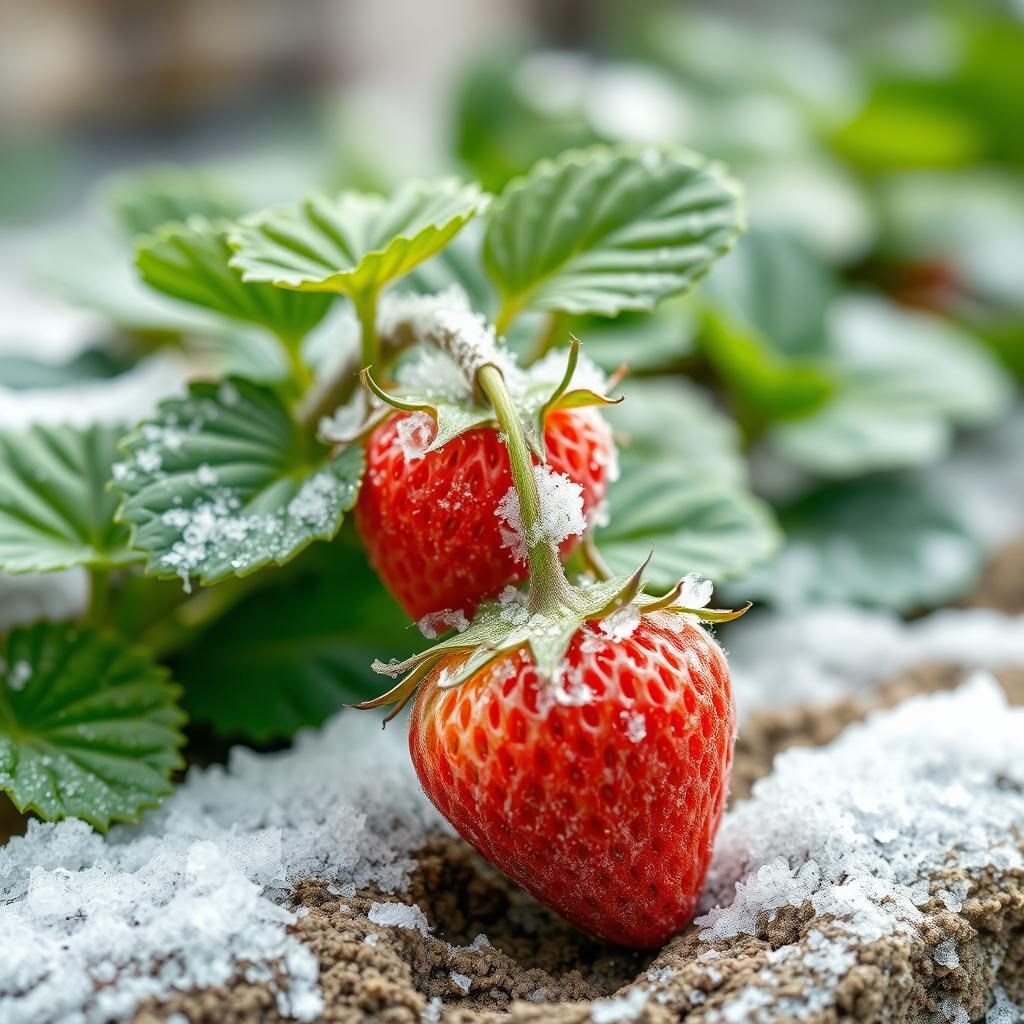Do Strawberries Grow in Winter? Understanding Winter Strawberry Growth and Care

Winter typically evokes images of dormant gardens and hibernating plants, but what if we told you that strawberries can thrive even in the coldest months? Understanding how winter strawberry growth works is essential for both novice and experienced gardeners who want to enjoy these delicious berries year-round. In this article, we will explore the conditions necessary for winter strawberry cultivation, the types of strawberries that can withstand cold temperatures, and the care strategies that can help ensure a bountiful harvest. Get ready to delve into the fascinating world of winter strawberry gardening and uncover the secrets to successful cultivation during the chilly season.
Do Strawberries Grow in Winter?
Strawberries are typically perennial plants that thrive in moderate climates, but their growth can be significantly affected by winter conditions. In most regions, strawberries enter a dormant state during the colder months, which means they do not actively grow, but they can survive the winter when properly protected. Some varieties, such as certain everbearing types, are hardy enough to produce fruit in mild winter climates, especially if provided with adequate insulation, like straw or mulch, to shield them from freezing temperatures. Therefore, while strawberries do not grow fruit in winter for the most part, their care and environment can influence their survival and potential early growth in the spring.
Strawberry Varieties and Hardiness
Different varieties of strawberries exhibit varying levels of winter hardiness. For instance, June-bearing strawberries tend to survive in more temperate climates, and they can be quite resilient in USDA zones 5-8, while everbearing varieties may produce fruit in warmer winters. The hardiness of a strawberry plant is often determined by its genetic makeup, leading some gardeners to choose specific cultivars based on their regional climate.
Winter Care for Strawberries
To ensure that strawberries survive the winter, appropriate winter care is crucial. Gardeners should consider mulching their strawberry beds with straw, shredded leaves, or pine needles to provide insulation against extreme cold and prevent the soil from freezing solid. Additionally, some gardeners may choose to cover their plants with fabric row covers during particularly cold nights to offer an extra layer of protection from frost.
Growing Strawberries in Greenhouses
For those desiring fresh strawberries even during winter months, growing them in a greenhouse is a viable option. A greenhouse provides a controlled environment where temperature and humidity can be managed, allowing for continuous growth. This method can enable gardeners to cultivate everbearing varieties that may yield fruit during the winter, thus prolonging the harvest season despite the external weather conditions.
See also:
Impact of Climate on Strawberry Growth
Climate plays a substantial role in determining if strawberries can produce fruit during winter. In mild climates, strawberries may continue to grow, albeit at a slower pace, which might lead to earlier blooming and fruiting in spring. Conversely, in harsher climates, sub-zero temperatures can hinder growth completely, requiring additional protective measures to help the plants survive until spring.
Signs of Strawberry Dormancy
Recognizing the signs of dormancy in strawberries is important for gardeners. During winter, plants will exhibit reduced foliage and may appear brown or wilted. However, these symptoms do not necessarily indicate the death of the plant; rather, they signal that the plant is conserving energy. Once temperatures rise in the spring, healthy strawberries will often show new growth, indicating that they have successfully survived the winter.
| Aspect | Details |
|---|---|
| Varieties | June-bearing, everbearing, and day-neutral |
| Winter Care | Mulching, covering, and maintaining moisture |
| Greenhouse Growth | Controlled environment for year-round harvest |
| Climate Impact | Influences growth patterns and dormancy |
| Dormancy Signs | Reduced foliage, wilting, and slowed growth |
Winter Strawberry Growth Conditions
Strawberries, while typically grown in warmer months, can indeed grow in winter with the right conditions. These berries are often grown as perennials, meaning they can survive through the cold, depending on the variety and climate. In regions with milder winters, such as USDA zones 7 to 10, certain types like day-neutral and everbearing strawberries can produce fruit throughout the winter months. To optimize growth, it is essential to provide protection from harsh temperatures and frost. Utilizing cover crops, mulches, or even greenhouses can help maintain suitable warmth and moisture levels for the plants to thrive during the winter season.
Choosing the Right Strawberry Varieties
Selecting the appropriate varieties of strawberries is crucial for winter growth. Day-neutral and everbearing strawberries are particularly well-suited for cooler climates as they can continue to produce fruit even when daylight hours are shorter. Their ability to set fruit under a wider range of temperatures makes them a favorite among gardeners seeking winter production. In contrast, June-bearing strawberries may not perform well, as they require longer days and warmer temperatures to thrive. Thus, understanding the growth habits of these varieties plays an essential role in successful winter strawberry cultivation.
Winter Strawberry Care Techniques
Caring for strawberries during winter involves several important techniques to ensure their health and productivity. Proper mulching is vital to protect the root systems from freezing temperatures. Organic materials like straw, wood chips, or leaves can provide insulation and prevent the soil from becoming too cold. Additionally, monitoring soil moisture is critical, as winter can bring dry conditions, and providing adequate watering when necessary can help keep the roots hydrated while avoiding soggy soil, which can lead to root rot.
See also:
Protecting Strawberries from Frost
Frost poses a significant threat to winter strawberries, especially when temperatures drop unexpectedly. To protect plants, employing methods such as row covers, fleece blankets, or even plastic tunnels can trap heat and provide a warmer microclimate around the plants. Home gardeners can also use cloches or cold frames to create a barrier against frost, ensuring that budding fruits and flowers are shielded from freezing temperatures. Careful timing and monitoring of weather conditions will further enhance the chances of survival for strawberry plants during particularly cold nights.
Optimal Watering Practices in Winter
During winter, the watering needs of strawberries change significantly. While it is important to prevent roots from drying out, too much moisture can lead to root rot and other fungal issues. The key is to provide consistent but moderate watering, which might mean reducing frequency during periods of cold or rain. Understanding when the plants need water, especially if there are frost-free days or warmer spells, is essential for maintaining healthy plants throughout the winter season. A moisture meter can be a handy tool for ensuring that the soil remains balanced.
The Role of Sunlight in Winter Strawberry Growth
Sunlight plays a crucial role in the growth and productivity of winter strawberries. Even in winter months when days are shorter, strawberries still require adequate sunlight to photosynthesize and grow properly. Ideally, a location receiving at least 6 hours of direct sunlight is optimal for winter strawberry care. If natural sunlight is insufficient, especially in areas with heavy cloud cover or shorter days, gardeners may consider using grow lights to supplement their lighting needs. Ensuring that strawberries receive the right amount of light can lead to better growth and higher fruit yields during the colder months.
Questions from Our Readers
Do strawberries grow in winter?
No, strawberries do not typically grow in winter. They are perennial plants that prefer warmer temperatures and usually go dormant during the winter months, especially in colder climates.
Can strawberries survive winter temperatures?
Yes, strawberries can survive winter temperatures, but they are susceptible to frost damage. Mulching can help protect the plants from extreme cold and retain soil warmth, allowing them to survive until spring.
See also:
What should I do to prepare strawberries for winter?
To prepare strawberries for winter, it's essential to ensure that they are properly mulched to insulate the roots. Additionally, water them before the ground freezes to ensure they have enough moisture during dormancy.
When will strawberries start growing again in spring?
Strawberries typically start to grow again in spring when temperatures begin to rise, usually around late March to early April, depending on the climate. This resurgence is marked by the emergence of new leaves and the development of flower buds.

If you want to read more articles like Do Strawberries Grow in Winter? Understanding Winter Strawberry Growth and Care, we recommend you check out our Gardeners category.
Leave a Reply
Related Articles